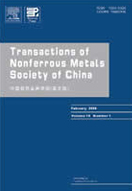Electrodeposition behavior of nanocrystalline CoNiFe soft magnetic thin film
(1. School of Materials Science and Engineering, Central South University, Changsha 410083, China;
2. Department of Chemistry, Zhejiang University, Hangzhou 310027, China;
3. Key Laboratory of Energy Resource and Chemical Engineering, Ningxia University, Yinchuan 750021, China)
2. Department of Chemistry, Zhejiang University, Hangzhou 310027, China;
3. Key Laboratory of Energy Resource and Chemical Engineering, Ningxia University, Yinchuan 750021, China)
Abstract: The electroplating behavior of nanocrystalline CoNiFe soft magnetic thin film with high saturation magnetic flux density (Bs>2.1 T) and low coercivity (Hc) was investigated using cyclic voltammetry and chronoamperometry methods in conjunction with the scanning electron microscopy (SEM/EDX). The results show that, under the experimental conditions, the co-deposition of CoNiFe film behaves anomalously due to the atomic radii of iron series elements following the order of rFe>rCo>rNi. In the case of lower electroplating current density, the co-deposition of CoNiFe film follows a 3-D progressive nucleation/growth mechanism, while in the case of higher electroplating current density, which follows a 3-D instantaneous nucleation/growth mechanism. Meanwhile, the change of nucleation mechanism of CoNiFe film with electroplating current density was interpreted theoretically in the light of quantum chemistry.
Key words: nanocrystalline CoNiFe film; soft magnetism; pulse-reverse electroplating; anomalous co-deposition; electrocrystalliza- tion mechanism

